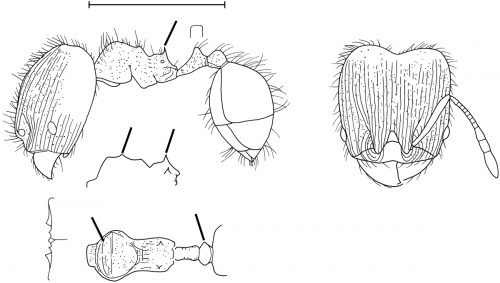Pheidole hazenae
| Pheidole hazenae | |
|---|---|

| |
| Scientific classification | |
| Kingdom: | Animalia |
| Phylum: | Arthropoda |
| Class: | Insecta |
| Order: | Hymenoptera |
| Family: | Formicidae |
| Subfamily: | Myrmicinae |
| Tribe: | Attini |
| Genus: | Pheidole |
| Species: | P. hazenae |
| Binomial name | |
| Pheidole hazenae Wilson, 2003 | |
Zona Buenos Aires, Colombia: in second-growth forest. (Wilson 2003)
Identification
See the description in the nomenclature section.
Keys including this Species
Distribution
Known only from the type locality and a single Colombian accession (Zona Buenos Aires, 600–800 m, Charles Kugler). In the second series the specimens are larger and darker than the type and may represent a distinct species. (Wilson 2003)
Latitudinal Distribution Pattern
Latitudinal Range: 9.4857096° to 9.4857096°.
| North Temperate |
North Subtropical |
Tropical | South Subtropical |
South Temperate |
- Source: AntMaps
Distribution based on Regional Taxon Lists
Neotropical Region: Colombia, Ecuador (type locality).
Distribution based on AntMaps
Distribution based on AntWeb specimens
Check data from AntWeb
Countries Occupied
| Number of countries occupied by this species based on AntWiki Regional Taxon Lists. In general, fewer countries occupied indicates a narrower range, while more countries indicates a more widespread species. |

|
Estimated Abundance
| Relative abundance based on number of AntMaps records per species (this species within the purple bar). Fewer records (to the left) indicates a less abundant/encountered species while more records (to the right) indicates more abundant/encountered species. |

|
Biology
Castes
Worker
Minor
Images from AntWeb
  
| |
| Worker. Specimen code casent0635473. Photographer J. Longino, uploaded by University of Utah. | Owned by JTLC. |
Nomenclature
The following information is derived from Barry Bolton's Online Catalogue of the Ants of the World.
- hazenae. Pheidole hazenae Wilson, 2003: 434, figs. (s.w.) ECUADOR.
Unless otherwise noted the text for the remainder of this section is reported from the publication that includes the original description.
Description
A medium-sized, yellow member of the flavens group, similar to Pheidole camilla but differing in the major caste in the moderately convex profile of the head (not bulging as in camilla), exclusively carinulate (as opposed to partly rugulose and rugoreticulate) sculpturing of the dorsal head surface, and the vertical, forward-curving propodeal spine as viewed from the side.
At 50–60X the tips of the mesosomal and gastral hairs are not flattened as in camilla. Also similar in some features to Pheidole alticola, Pheidole euryscopa, Pheidole heterothrix, Pheidole rectiluma, Pheidole rectisentis, Pheidole rectispina and Pheidole rectitrudis, and notably different in others as illustrated.
Minor: not diagnosed.
MEASUREMENTS (mm) Major: HW 0.86, HL 0.90, SL 0.46, EL 0.10, PW 0.40.
COLOR Major: concolorous yellow.
Figure. Unique holotype, major. Scale bars = 1 mm.
Type Material
ECUADOR: Rio Palenque Station, 47 km south of Santo Domingo, Pachincha, col. Stewart B. and Jarmila Kukalová-Peck. Museum of Comparative Zoology
Etymology
Named in honor of Anne-Eve Hazen, in recognition of her outstanding contribution in service and support to tropical conservation, hence the habitats in which the Pheidole ants will continue to exist.
References
- Wilson, E. O. 2003. Pheidole in the New World: A dominant, hyperdiverse ant genus. Harvard University Press, Cambridge, MA. (page 434, fig. major described)
References based on Global Ant Biodiversity Informatics
- Fernández, F. and S. Sendoya. 2004. Lista de las hormigas neotropicales. Biota Colombiana Volume 5, Number 1.
- Longino J. T. L., and M. G. Branstetter. 2018. The truncated bell: an enigmatic but pervasive elevational diversity pattern in Middle American ants. Ecography 41: 1-12.
- Longino J. et al. ADMAC project. Accessed on March 24th 2017 at https://sites.google.com/site/admacsite/

